ABOUT TO UNFOLD

Unforgettable you can leave the islands, but never forget them





Unforgettable you can leave the islands, but never forget them



everything seems simpler at a distance, like your new strategy.

























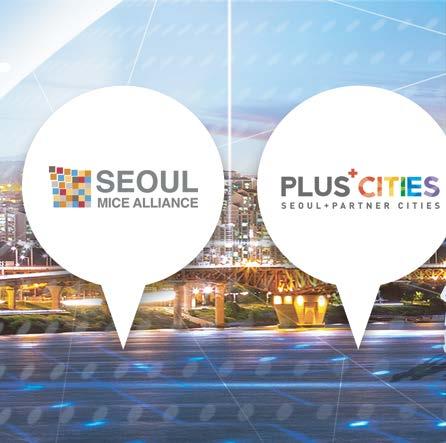
by providing sanitizing products for participants and staff and rentals of equipment such as a thermal-detecting camera and a disinfecting gate. Seoul MICE Safety Care Service offers tota






has established multi-layered



are close partners of the Seoul




Korean
City




and regions.
from loca
The CICG is a second-to-none facility intended to host international conferences at government level, of a political, economic and technical nature, but also any other type of private congress. With six large plenary rooms, sixteen committee rooms, multipurpose and exhibition areas, as well as offices, lounges, a co-working area and various catering spaces, the CICG offers flexible solutions to organize your events of any size.

Since its inauguration in 1973, the CICG has undergone a series of major renovations between 2004-2005. This has notably enabled the Centre to expand and create a larger mul tipurpose space meant to host cocktails, larger exhibitions but also contain additional meeting rooms.
The year 2020 marked a milestone with the moder nization of all our IT and AV systems. It includes the audio visual system in the rooms, digital signage as well as all the IT infrastructure (guaranteed WIFI service with no downtime). A mobile application for partici pants has also been developed.
All these technical reno vations allow us today to host all types of events in the best conditions while taking into account the current constraints imposed by the health crisis which has hit our business sector in a very hard way. Whether they are face-to-face, hybrid or virtual, our role is to support our clients in the realization of their event in these new formats. New virtualiza tion tools are being introduced and a TV studio is now available.





This year, the CICG has taken on the challenge of giving itself a new face and a decidedly more modern, luminous and airy style in record time.



















































Through the “In Earth We Trust” project, the main idea is to put the planet and humanity at the centre of concerns with particular attention to health and environment issues.
In fact, in just four months, significant works have been undertaken at several levels. In addition to more technical works such as flooring, ceiling cladding, renovation of the hydraulic units of movable room walls and podiums as well as the ventilation system, new spaces have also emerged.



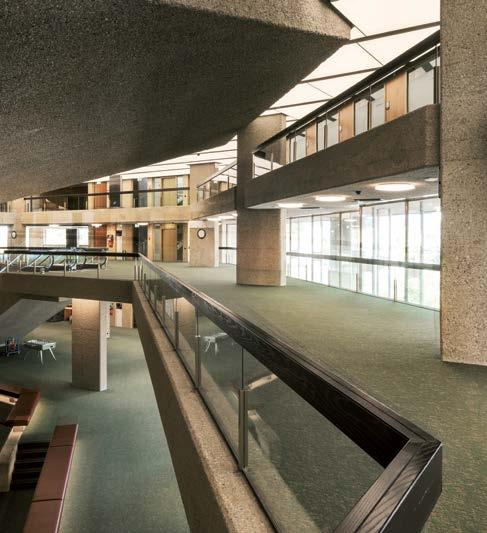
The Café, called the Sixth Continent, is warm and envel oping in the spirit of a hotel lobby. The bar is clad in natural stone (from the south of the Alps) while the walls are clad in red wood (Swiss larch).

In the same spirit, we now find the Club Lounge (L’Esprit de Genève) nestled in the main hall. The space offers a very cosmopolitan atmosphere in



a vintage decor. A truly ideal place conducive to exchanges and meetings.
The coworking space offers a shared work environment that is both open, friendly and discreet, ideally located a stone’s throw away from Café Le 6ème Continent.
This new space offers a stimulating and secure professional environment for organizing work sessions on one’s own or in small groups. l



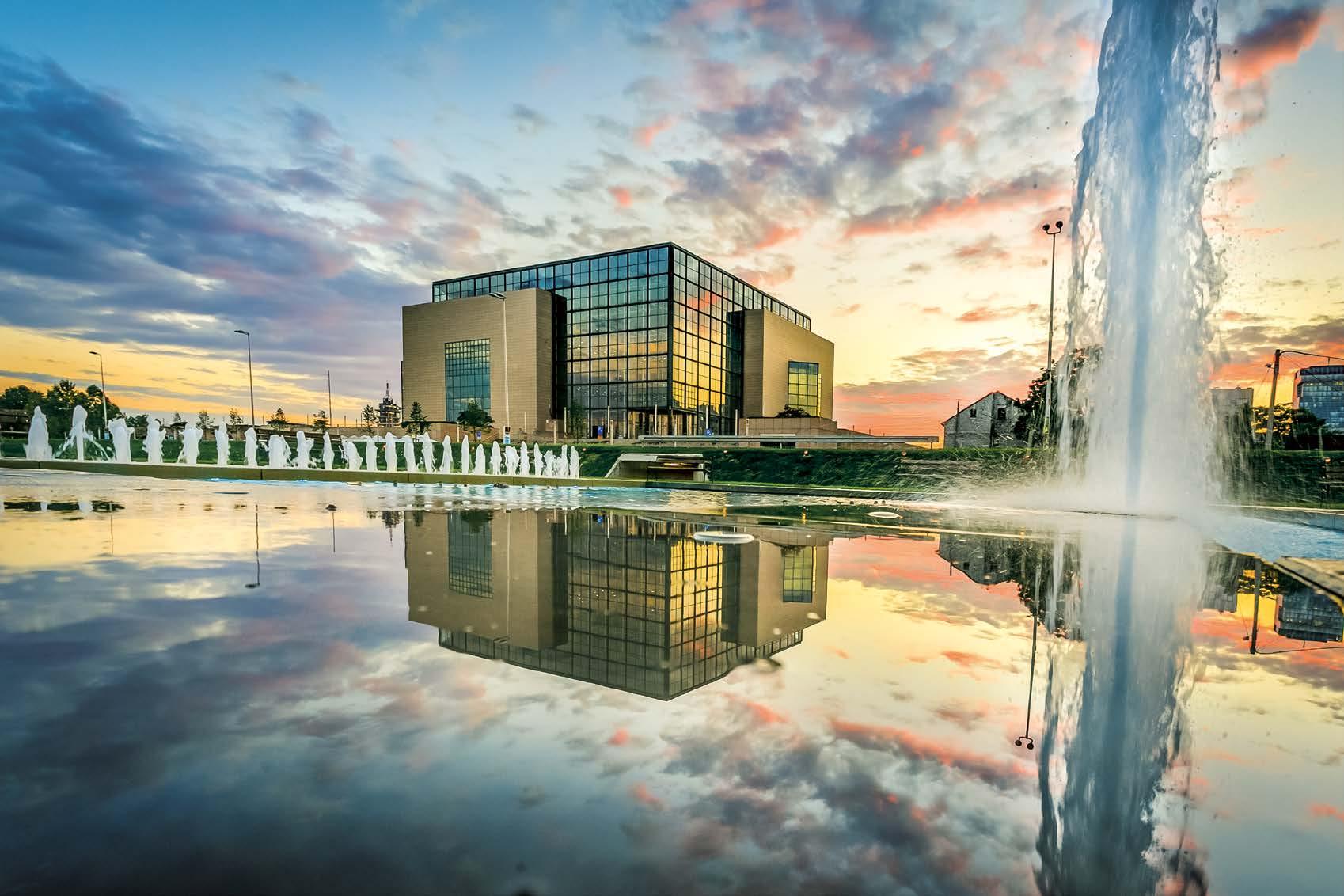

 S.KAŠTELAN
D.ROSTUHAR
ESPLANADE ZAGREB HOTEL
M.VRDOLJAK
photos J. Duval (top), M. Gasparovic (round)
S.KAŠTELAN
D.ROSTUHAR
ESPLANADE ZAGREB HOTEL
M.VRDOLJAK
photos J. Duval (top), M. Gasparovic (round)
Truly unexpected and challenging, the Covid-19 crisis, has caused different degrees of disruptions, postponements or even cancellations of many meetings and events globally. Staying safe and healthy, being responsible in all our actions and projects is one of everyone's top priorities right now.
Zagreb has been preparing for the days ahead looking to upgrade the local meetings and events infrastructure, as well as to boost competence and skills of meetings and events industry creative teams. In place of old “normal”, the innovative approach to meetings and incentives is taking place.
In this current climate Zagreb, the capi tal of Croatia, the Central European city with Mediterranean flair, is safely opening up for business again.

The rich culture and history, legends and stories, the old and the contemporary are all on display as you stroll down the streets of Zagreb, and are also presented in numerous sightseeing tours, many of which are interactive.

The venues range from some of the most beautiful historic buildings in the romantic city core to business hotels downtown. For outdoor meetings or activities, you can always choose one of many elegant urban parks or picturesque downtown squares and
pedestrian zones centrally located. Zagreb has the “sea” – Jarun Lake recreation area with great sports and picknick facilities, as well as Bundek Lake staging cultural activities and shows. Alterna tively, one can opt for Mt. Medvednica – the green “lungs” of the city. Memorable incentives are guaranteed.
Zagreb offers a great variety of gastronomic experiences ranging from typical local to international dishes. They can be enjoyed in restaurants, but also in small ven dors offering street food during numerous festivals all year round.
The Zagreb surroundings showcases unspoilt nature with tranquil landscapes, romantic mediaeval castles and legends, wine roads, spas, hiking and cycling trails, golf expe riences and many more. Less than a two hour drive is the Adriatic coast, ideal for a memorable incentive or a pre or a post tour. In the vicinity is also the world famous Plitvice Lakes National Park included on the Unesco World Heritage list.
Whenever you plan your next event, think about Zagreb – the safe and vibrant Central European metropolis where captivating city atmosphere and making business make a perfect match.
Welcome to Zagreb, your next meetings and incentive destination!
SPONSORED CONTENTINTRO Atti Soenarso on the world's first truly global event.
SOCIO-ECONOMIC IMPACT Whether gazelle or lion, Africa is awakening and running faster than yesterday.
FUEL BUSINESS CONNECTI v ITY Over 190 countries are participating, bringing their best offers to the table.

ATTRACT IN v ESTMENT The youngest, fastest-growing continent on the planet have been making huge strides.
COLLABORATION The narrative of Africa has shifted and its stakeholders aspire for a future full of possibilities.
ECONOMIC GROWTH Study shows Senegal is well-positioned to expand its role as a regional business hub.

LONG-LASTING IMPACT The business programme of Expo 2020 is full of opportunities.
28 20 Shifts on the Path to 2030 RAPIDLY CHANGING REALITY Aftershocks and opportunities – navigating the next horizon.
42 Moving From Virtual to Hybrid Events HYBRID E v ENTS Hybrids will likely see widespread adoption for a number of reasons.


48 Business Event Management of the Future RESEARCH Many associations were ready to pivot and move their events online.
53 Evolving the Role of Convention Bureaus DESTINATION PLANNING Staying relevant in a rapidly changing marketplace as well as in your respective destination.
RETHINK A new tact is required: Here is how we think the return of face-to-face live events will look.
58 Expo 2020 Sustainability Pavilion Will Show How Far We Have Come KELLERMAN Roger Kellerman on mindsets and skillsets for thriving while society and nature regenerate.
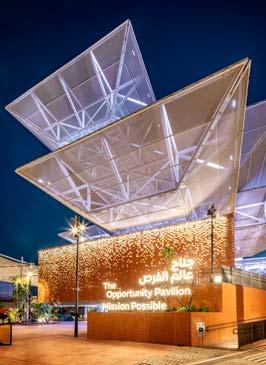
LEGALLY RESPONSIBLE EDITOR IN CHIEF Atti Soenarso atti.soenarso@meetingsinternational.com
PUBLISHER Roger Kellerman roger.kellerman@meetingsinternational.com
GLOBAL SALES DIRECTOR Graham Jones graham.jones@meetingsinternational.com
TEXT Per Ankaer, Corbin Ball, Deborah Edwards, Carmel Foley, Matt James, Roger Kellerman, Atti Soenarso, Rohit Talwar, Rick Taylor, Paul Vallee
PHOTOS / IMAGES Sara Appelgren, Cecilie Arcurs, Cover Illustration: iStock.com/Vectorios2016, Jonathan Erasmus, Monsit Jangariyawong, Garry Killian, Vasin Leenanuruksa, Magnus Malmberg, Atti Soenarso
DESIGN KellermanDesign.com
EDITORIAL RAYS OF SUNSHINE Yun Long Ong, RIP + Miss Tokio + Jock Zonfrillo + ABBA Voyage + Marion Grasby
SUBSCRIPTION Subscribe at www.meetingsinternational.com or subscription@meetingsinternational.com
CONTACT Meetings International Publishing Betonggatan 1, SE-216 46 Limhamn, Sweden info@meetingsinternational. com www.meetingsinternational. com
PRINTING Trydells, Laholm [environmentally certified, ISO 14001]
PAPER Arctic Paper Munken Lynx 240g/100g FSC labeled paper Cert No SGS-COC-1693
1651 9663
The World Expo is one of the largest global, non-commercial events in economic and cultural impact after the FIFA World Cup and the olympic Games.
The 170 -year-old tradition of world fairs is about to meet with a historic moment as Dubai hosts the World Expo 2020. It is the first time a country from the Middle East is host ing what is often cited as the world's “first truly global event.”
From their origins as international gatherings of states showcasing industrial power and technologi cal innovation, World Expos have evolved to become platforms for the international community to debate, probe, share best practices, and explore new solutions for the chal lenges our planet faces.
The first mechanical computer was showcased at the London Inter national Exhibition of 1862 , and Alexander Graham Bell demonstrated the first telephone at the Philadelphia world fair in 1876 . other notable introductions at these international events are, for example: the elevator and the dishwasher, the Ferris wheel, the Eiffel Tower and the Seattle Space Needle, the ice cream cone
and Cherry Coke, the x-ray machine and computer touchscreens, as well as broadcast television along with the first television sets, and later on colour television.
In the modern era, World Expos are large-scale platforms for educa tion and progress that bridge gov ernments, companies, international organisations, and citizens.
Another aspect of this period in the history of World Expos is the focus of themes around global chal lenges such as sustainability, climate change, the food crisis, among others.
The expo in Shanghai in 2010, for instance, was themed upon “Better City, Better Life.” The theme of Milan in 2015 was “Feeding the Planet, Energy for Life”, and the theme at Dubai this year is “Connecting Minds, Creating the Future,” with three sub themes of opportunity, mobility and sustainability. The following World Expo will be in 2025 in osaka, Kansai, Japan, under the theme “Designing Future Society for our Lives.”
For millions of people, Expo 2020 Dubai is an occasion to reconnect with the whole world, engage with critical questions of universal impor tance, and showcase innovative and
cutting-edge solutions to our global problems. Every participating coun try has its own pavilion at Expo 2020 Dubai for the first time in World Expo history.
India, which is yet to host a World Expo, is to have the largest pavilion in Dubai where the four-storeyed pavil ion is designed to showcase 75 years of India's Independence.
Under the exhibition titled “New Perspectives,” the Women's Pavil ion invite visitors to recognise the central role that women, known and unknown, have played throughout history, leading up to the present. Celebrating women's significant and often forgotten contributions, the pavilion will demonstrate an impor tant principle: when women thrive, all of humanity thrives.
Burton Benedict, an American anthropologist, summarises the importance of World Expos in his 1983 book: “They were selling ideas: ideas about the relations between nations, the spread of education, the advancement of science, the form of cities, the nature of domestic life, the place of art in society.”
Swedish-Indonesian Atti Soenarso has worked as a journalist for close to 40 years. She has worked for Scandinavia's largest daily newspaper, was TV4's first travel editor, has written for many Swedish travel magazines and has had several international clients. She has travelled the length and breadth of the world and written about destinations, people and meetings.


He has only one thought on his mind: To run faster than the fastest lion. If he cannot, then he will be eaten. Every morning in Africa a lion awakens. He has only one thought on his mind: To run faster than the slowest gazelle. If he cannot, he will die of hunger. Whether a gazelle or a lion, with the rising of the sun, Africa is awakening and running, faster than it did yesterday.
TEXT Rick TaylorAfrica has been underperform ing in business event arrivals for decades, recording only 3 per cent of international association meetings in 2019 and 6 per cent of international organisation and association meet ings according to the International Congress and Convention Association (ICCA) and the Union of International Associations (UIA) respectively.
This is supported by the Events Industry Council that recorded only 5 .3 per cent of global business events participants and 2 .2 per cent of global direct spending in Africa in 2018 .
The top-performing business event countries in Africa are South
Africa, ranked 38 th globally by ICCA in 2019, followed by Morocco at 57th, Rwanda at 64th, Egypt at 66th and Kenya at 69 th.
Africa is 30 1 million km² in size, making up 20 3 per cent of the earth's total land area. Its 54 countries (and one sovereign state) are home to 17 4 per cent of the world's population, an estimated 1373 billion people in 2021 according to the latest United Nations estimates and projected to grow to 2 .4 billion by 2050.
Sub-Saharan Africa is the region with the world's youngest population with a median age of 19.5 compared to 38 in the US, 43 in the EU and 47 in
Japan. It is estimated that 20 mil lion young people will be joining the workforce every year for the next three decades (Africa Center for Eco nomic Transformation).
Africa's total GDP is estimated at US$ 2 .6 trillion. Against the aspira tions of the African Union's Agenda 2063 (the plan for transformation that aims for a peaceful, integrated
global trade and professional asso ciations and manufacturers of con sumer goods where a strong market economy is a key demand driver for business events and exhibitions.
East Africa has been the rising star for the past decade and the conti nent's most recent growth region for business events. National convention bureaus have been established in
bureaus that understand the techni calities of the sector and that are fully skilled to raise awareness into public and private sectors as to the enor mous socio-economic benefits that cascade into the economy through hosting international business events.
Rwanda is an example of remark able success in the growth of business events in an African destination. Rwanda was ranked number three in Africa (after South Africa and Morocco) by ICCA in 2019, and num ber 64 globally, ahead of Egypt and Kenya that make up the top 5 on the continent.
and prosperous continent by 2063), Africa's tourism competitiveness is increasing as destinations scale up their development agendas, specifi cally into the business events sector.
The Business Tourism Company has, over the past two decades, pur sued a growth plan for Africa's share of the global business events sector, with the catalyst for success being in establishing professional, skilled national convention bureaus to drive the agenda forward.
In recent years, liberalising air transport and further relaxation of visa rules, easier currency convert ibility, Afro-optimism and business events infrastructure develop ment outside of South Africa has been mushrooming throughout the continent.
World-class convention and exhibition centres and international branded hotels with excellent meet ing capabilities are fast appearing on skylines in Dakar, Kigali, Nairobi, Addis Ababa, Dar es Salaam and beyond.
Africa's middle class is expand ing rapidly, drawing interest from
Rwanda, Kenya and Ethiopia, with Uganda and Tanzania in the makings, building awareness of the business events industry as an essential con tributor to national economies. The centre of gravity has now moved to West Africa, with Senegal, Ghana and Togo exploring their business event sector options.
As is the case the world over, Covid-19 has unquestionably been a catalyst for change. This is an impor tant time for our industry to redefine our relationships, consider future markets, and explore new opportuni ties to deliver business value.
This holds true both for the inter national business event organiser looking for growth markets and for each of Africa's economies looking to expand the socio-economic benefits into their communities through host ing global business events.
So, why has Africa underper formed in the business events sec tor, except South Africa, Egypt and Morocco that have been actively engaged for some two-plus decades?
We believe strongly that it is because of a lack of convention
When you compare the size of these countries in terms of GDP and population to Rwanda, the success achieved by this small nation is remarkable. It can be attributed to the buy-in from the top echelons of the public sector and a convention bureau that understands its mandate and proactively engages in sales and bidding activities.
Adding to Africa's appeal as a region for hosting international asso ciation congresses is the growth of the professional middle class. Africa's population is growing faster than that of any other region, and it is the middle class that is expanding most rapidly.
In less than a decade, Rwanda has demonstrated the potential that awaits Africa (see table ➚).
According to the African Develop ment Bank, by 2030, Africa's middle class will comprise over 300 million people who will spend US$ 2 2 trillion a year between them. Professional associations are attracted to desti nations offering the opportunity of gaining new members, and African countries increasingly provide fertile recruiting grounds for associations.
The business events industry in Africa has resumed operations
“The top-performing business event countries in Africa are South Africa, Morocco, Rwanda, Egypt and Kenya”
Country
South Africa National Convention Bureau
Launched in 2004 , plus 6 regional and city CBs
Moroccan Convention Bureau Launched in 2009
Rwanda Convention Bureau
Launched in 2014
Formalised in 1989
38 1st in Africa
57 2nd in Africa
64 3rd in Africa
66 4th in Africa
Kenya Convention Bureau Launched in 2019 #69 5th in Africa
with countries such as South Africa, Kenya, and Rwanda. They have published comprehensive Event Re-opening Guidelines and Covid-19 safety checklists. Also, they have adopted the WTTC Global Safety Stamp that recognises safe travel pro tocols, alongside Uganda, Tanzania, Ghana, Namibia and Zambia.
In most countries, borders are open to international and regional delegates, with live events limited to around 50 per cent of room capaci ties. In Senegal, hotel venues are currently operating at almost total capacity hosting local and regional meetings.
Live-streaming technology has been embraced, and whilst the ben efits of virtual and/or hybrid events have been recognised, industry experts remain confident that people realise and appreciate the value of live, face-to-face events more than ever.
In Africa, we have come to under stand the extent to which we are glob ally interconnected and how much we depend on each other, not just for trade but for knowledge and informa tion sharing.
As an industry, the focus will be firmly placed on the economic, social
and environmental legacy benefits that business events can bring to African destinations. This must be extended to include enhancing skills development in Africa's bright young graduates.
Knowledge must be purposefully dispersed to ensure that the business events sector helps meet our youth's future professional development aspirations.
Through the rising convention bureau development in Africa, global meeting, incentive and exhibition clients will be encouraged through harder working sales and marketing activities to step outside of their com fort zones and explore a continent brimming with iconic abundance, warm and openhearted people, and the new experiences that await their delegates in Africa.
Might the Covid-19 pandemic experience encourage greater inter national cooperation and openness out of self-interest? This would impact Africa's business events sector positively.
Let's stand together as one Com munity, one Industry, one Africa … awakening to the realisation that business events will drive the future we want for our continent.
38 US$387 billion 60 million
59 US$129 billion
million
140 US$11 billion 13 million
42 US$331 billion 104 million
61 US$109 billion 55 million
“As Africans we need to share common recognition that all of us stand to lose if we fail to transform our Continent” — Thabo Mbeki (former president, South Africa)
Rick Taylor of The Business Tourism Com pany was the first tourism leader in Africa to recognise the potential socio-economic benefits of the business events sector. He set up Africa's first Convention Bureau, the Cape Town Convention Bureau, in 1998 . Cape Town has since retained the number one city ranking position in Africa by ICCA for over two decades.

Expo 2020 Dubai has opened. With Covid-19 protocols firmly in place, the emirate is gearing up to welcome visitors from wide and far. over 190 countries are participating, bringing their best offers to the table. Here is a look at 14 things to know about this mega-event.
1. In November 2013 , Dubai won the World Expo hosting bid, making Expo 2020 Dubai the first world exposition ever to be held in the Middle East, Africa and South Asia region (MEASA). Also, it is the biggest event in the Arab world to date.
2. 192 participating countries will have their standalone pavilion.
3. From a bird's eye view, the venue resembles three flower petals. Each petal is a Thematic Dis trict: opportunity, Mobility and Sustainability.
4. At the heart of the venue is Al Wasl Plaza, the world's largest 360 -degree projection surface, constructed with 13 6 kilometres of steel. Think the height of 16 Burj Khalifa's stacked on top of one another.
5. The Sustainability Pavilion, Terra, is built to be net-zero for both energy and water. Among
the solar-panelled Energy Trees, the self-sustaining building will also host a Water Tree to capture water from the air.
6. The Mobility Pavilion, Alif, is home to the world's largest pas senger lift, a spacious platform that can carry up to 160 passen gers at a time to the third level of the building.
7. The opportunity Pavilion: Mission Possible. This pavilion builds on the rich urban history of the “plaza” and its universal significance as a place for people to connect across age, language and culture, to celebrate our shared human experiences.
8. Expo is dedicating an entire pavilion to celebrate women and the multiple vital roles in society. The Women's Pavilion has been a first for World Expo's since the 1900 s.
9. Expo 2020 Dubai has gathered 142 social innovators from 76 countries to help solve some of the most challenging problems of our era as part of Expo Live.
10. Are you worried about visiting Expo and the Wi-Fi being on the fritz? It is becoming less of a pos sibility thanks to the introduc tion of 5G.
11. Approximately 340 species of plants, shrubs and grass, many native to the region, make up the Expo landscape.
12. The Good Place Pavilion will spotlight social innovators and their solutions, a first for a World Expo in history.
13. Expo is building down to talk about the issues inherently relevant to our time. At the World Majlis Forum, global thought leaders will come together to generate new perspectives and connections, just as a theme of the mega-event dictates: Con necting Minds, Creating the Future.
14. So, what is happening after the Expo closes on March 31 next year? A whole new district will be coming to life next october, a smart future-ready town called District 2020. As per Expo's sustainability plan, the city will inherit 80 per cent of the Expobuilt buildings for the event.

Expo 2020 Dubai is the first megaevent to take place in the Middle East, Africa and South Asia region.
As one of the biggest global events for six months, the expo is an arena for world countries to showcase their creativity, innovations, progress across industries and cultures.
Expo 2020 Dubai is built on an ethos of one Nation, one Pavilion. This means that, for the first time at a World Expo, each of the 192 partici pating nations will have its pavilion.
Expo's subthemes of opportu nity, Mobility and Sustainability will inspire visitors to preserve and pro tect our planet, explore new frontiers and build a better future for everyone.
For example, every African nation, from South Africa to South Sudan, the world's youngest country, has signed up to participate and showcase its culture and innovations. Also, there will be a pavilion for the African Union.
Africa is the youngest, fastestgrowing continent on the planet. Huge strides have been made since the organisation of African Unity was founded in 1963 and will continue that momentum at Expo 2020 Dubai. Everything Africa has to offer will
be accessible to the world in differ ent ways, boosting collaborations, encouraging connections and helping drive overall progress.
Some programs with relevance to the realities in Africa
Nigeria's presence will propel con versations in areas such as agri culture, manufacturing and the creative industries by showcasing the country's culture to the world.
The pavilion will create an oppor tunity City with streets bursting with energy, including Resilience Avenue, Respectful Avenue, Hard working Avenue and Enterprising Avenue.
Nigeria has scheduled 23 custom ised events featuring Afrobeat music and the burgeoning Nolly wood film scene, highlighting its cultural, creative and economic opportunities.
out of 140 Global Innovator organisations, 36 are making a significant impact in Africa.
Two of the innovative organisa tions from Africa that will be given a platform at the event are Hydro ponics Africa from Kenya and Rwanda's Nuru Energy.
Hydroponics Africa addresses poverty and food sustainability through cost-effective sustaining farming methods without soil and with an 80 per cent reduction in water use. And visitors will learn how Rwanda's Nuru Energy pro vides affordable solar and humanpowered electricity that village entrepreneurs can sell.
The Global Business Forum Africa in october alone will offer networking opportunities and the chance to hear from speakers on topics surrounding economic recovery in the wake of the pan demic, with a specific focus on trade opportunities.
Sessions will cover areas such as how Africa can attract investment from overseas and the importance of strengthening sustainable finance, among many other topics.

Africa is undergoing a dynamic socio-economic and political trans formation. It is a continental market with 55 countries, and 1 .7 billion people and growing. Also, the conti nent is home to several of the world's fastest-growing economies.
Expo 2020 Dubai will be the first World Expo in the Middle East, Africa and South Asia (MEASA) region since its inception in 1851
The purpose of the Expo is to bring participants and businesses closer to the world's fastest-growing markets and create opportunities for access ing a region of more than 3 .2 billion people with a collective GDP of more than US$ 6 .5 trillion.
The African Union (AU) has been designated as a key partner and stake holder by the United Arab Emirates (UAE) Government, which has offered a pavilion to the African Union and is committed to a strong spirit of collaboration and cocreation during every step leading to Expo 2020
The African Union Pavilion pro vides an opportunity for the world to understand AU's institutional history, continental development and repre sents a platform for Africa to tell its story to the world.
In the pavilion, you will learn sto ries of, for example, Africa's achieve ments in different vital sectors,
highlight opportunities for invest ment underlined in Africa's develop ment blueprint and Agenda 2063 aspirations to capture the essence and progress of the continent.
The narrative of Africa has shifted, and Africa's stakeholders, its citizens, are seeking partners who aspire like them for a future full of possibilities and will work with them collabora tively to achieve the Vision of Africa's Agenda 2063
Launched in 2013 , Agenda 2063 is a strategic framework, Africa's Devel opment Blueprint, for the continent's socio-economic transformation for the next 50 years. It's built on and seeks to accelerate the implementa tion of past and existing continental initiatives for growth and sustainable development.
The organisation of African Unity (OAU) was formed in 1963 and advo cated for African unity and solidarity and fought for independence from colonialism and apartheid. It was re-launched as African Union (AU) in 2002 to spearhead Africa's Develop ment and Integration and comprises 55 countries.
The African Union Pavilion is located in the opportunity District.

With Senegal's capital city of Dakar located on the westernmost point of Africa, the country is well-positioned to expand its role as a regional busi ness hub. Dakar has become an aviation hub for West Africa and has connections with multiple locations in Africa, Europe, and the Middle East. Senegal has a population of 16 .7 million inhabitants, a quarter of whom live in the Dakar region.
Based in Cape Town, South Africa, the Business Tourism Company con ducted a feasibility study of Senegal in July 2021 to determine its market readiness for business events.
“The outcome of the study was overwhelmingly positive,” says Colette Taylor, director of the company.
over the past decade, the Govern ment of Senegal has embarked on a series of economic reforms that have been accelerated through the Plan Sénégal Emergent (PSE II) develop ment masterplan.
PSE II aims to boost sustained and inclusive economic growth and make Senegal an emerging economy by 2035 . The high potential sectors prioritised for development in the Priority Action Plan (PAP2) are agri culture, health and pharmaceuticals, digital transformation, air transport and tourism, supported by education and community development.
Foreign exchange earnings are from mining, fishing, groundnuts, cotton, tourism and the services industry. More recently, significant reserves of gas, oil and renewable
energy are sectors with great growth potential.
Senegal is one of the most stable countries in Africa, with three peace ful political transitions since inde pendence in 1960. The economy grew by more than six per cent per year from 2014 to 2018 (pre-pandemic). Moreover, the country is home to five cultural and two natural UNESCO world heritage sites and eight sites on the tentative list.
The launch of Sénégal Internet Exchange Point (SENIX) in 2017 and the Digital Sénégal Strategy 2025 (in which digital transformation of the economy has become a major objec tive of Government) supports a posi tive and competitive ICT environment for business events.
“What was surprising to find was how actively Senegal has been engaged in business events for decades, and what excellent marketready facilities there are for hosting events, from small to large capacities of 3000,” says Colette Taylor.
Venues such as Centre Inter national du Commerce Extérieur du Sénégal (CICES) and King Fadh Palace Hotel have been hosting business events for more than 30 years.
The world class Centre Inter national de Conférences Abdou Diouf (CICAD) in Dakar–Diamniadio opened in 2014 when it hosted its first inter national conference, the 15th Franco phone Summit.
In addition, the Centre des Expo sitions de Dakar that was completed in 2018 is the largest in West Africa,
offering six halls with the biggest at 4800 m² column-free space.
Furthermore, several hotels with meeting facilities have been hosting national, regional and international conferences for many years.
Twenty-three per cent of inter national arrivals to Senegal are busi ness, with French-speaking markets (including ECOWAS) accounting for 42 per cent. The country's proximity to Europe and the USA makes access for international delegates easy.
“Economic growth of key industry sectors, unique cultural and natural attractions, from deserts to mangrove swamps, and the excellent cuisine are real assets for Senegal that have strong business events promotional potential,” says Colette Taylor.
one of the country's infrastruc tures development is the new port of Dakar which will be located about 50 km down the coast and close to Blaise Diagne International Airport, which opened in 2017.
The port is expected to be com pleted by 2026 and will create jobs, attract new foreign direct investment to the country, and enable new trad ing opportunities that bring about economic diversification.
At Expo 2020, Dubai Senegal is located in the Mobility District. Here you can discover Senegal's major pro jects in the development of mobility, people, goods, services and data, and see more of the nation's substantial infrastructure developments.
The business programme of Expo 2020 is full of opportunities for networking, knowledge-sharing and growth.

The business events calendar includes three Global Business Forums. To fuel the business con nectivity, there is a Business Connect Centre and an AI-powered B2 B app. Also, there are programs to foster sustainable partnerships for a more resilient global economy.
Expo 2020 has announced the launch of Thrive Together. It is a dedicated, business-focused pro gramme offering a range of curated
networking, knowledge-sharing and thought-leadership events.
The Thrive Together programme will include several Thematic Busi ness Forums delivered in collabo ration with the Dubai Chamber of Commerce and Industry. These events will highlight emerging busi ness opportunities, cutting-edge technologies and serve as a platform to connect, create and innovate.
They will also accelerate private sector progress across current global challenges, including climate change and biodiversity, space, and knowl edge and learning.
Three Global Business Forums (GBFs), including the first edition of Global Business Forum ASEAN, will take place at the Dubai Exhibition Centre (DEC), Expo 2020 Dubai.
These GBFs will welcome promi nent speakers, leading decision-mak ers and industry experts to explore business synergies and address obstacles to growth, driving trade and investment and fostering economic development.
Meanwhile, Country Business Briefings will enable each of Expo's participants to leverage the presence of their heads of state or government
and their business leaders to show case their country-specific business and investment opportunities to a global audience.
Products and services offered as part of Thrive Together include an AI-powered app, facilitating meaning ful B2 B, B2 G and G2 G interactions across geographies and industries, suggesting potential matches for users based on their profiles, exper tise, objectives and interaction patterns.
An easily accessible Business Cal endar will be updated daily and carry the latest information on inbound business delegations and all business events across the Expo site, including in Dubai Exhibition Centre, Interna tional Participants' pavilions, and the Expo 2020 Business Connect Centre.
Sitting at the heart of the Expo site, adjacent to the iconic Al Wasl Plaza, the Business Connect Centre will house chambers of commerce and trade entities from across the region, representing more than one million companies, as well as invest ment houses and venture capitalists.
Hassan Al Hashemi, Vice Presi dent, International Relations, Dubai Chamber of Commerce and Industry, says:
“Dubai Chamber is committed to representing and supporting the interests of businesses in Dubai while exploring new ways to meet the changing needs of the emirate's fast-growing and dynamic business community as we navigate the pan demic era.
“As Expo's official Business Inte grator, we are pleased to be part of the wide-ranging Thrive Together pro gramme. We believe it will be a pow erful catalyst for fostering innovation and entrepreneurship, addressing key challenges affecting business growth, attracting international companies to Dubai and facilitating collaborations across sectors and geographies. It will create an immediate and long-lasting impact for Dubai, and ripple across the UAE, wider region and beyond.”
Created specifically for the busi ness community, both domestic and international, the Thrive Together programme will include some The matic Business Forums delivered in collaboration with the Dubai Cham ber of Commerce and Industry.
These events will highlight emerging business opportunities, cutting-edge technologies and serve as a platform to connect, create and innovate.
They will also accelerate private sector progress across current global challenges, including climate change and biodiversity, space, knowledge and learning.
An enhanced ticket package has been created for business-focused visitors. The Premium Experi ence Season Pass offers additional networking and add-on services to assure a seamless visitor experience.
It includes complimentary enhanced access to the Expo B2 B app, a dedicated concierge, entry to a Premium Lounge, priority access to many networking and thought leadership events, including the ten Thematic Business Forums, guided tours and F&B discounts.
The Premium Experience ticket, priced at AED 1750, allows unlim ited visits across the six months of the event, including fast track entry. The ticket will be available at expo2020 dubai.com/tickets and through Expo's network of business stakeholders.
“It will be a powerful catalyst for fostering innovation and entrepreneurship, addressing key challenges affecting business growth”

What are some of the emerging future factors that could turn into influential shifts shaping the next decade and beyond?
This book provides a broad scan of the horizon for some of the critical future factors that might shape our world over the next five to ten years and beyond. The contributors discuss a number of megatrends, clearly iden tifiable subtrends, and emerging ideas that we already believe will have some influence on the scenarios that could play out. In this chapter, we take a look beyond those strong drivers of change to look at some of the rapidly evolving developments and weaker signals of possible change that could turn into major societal shifts quite rapidly. These factors are grouped under operating environment, lives and lifestyles, economy, and business and technology. Many of the future factors highlighted below have a close relationship to the United Nations' 17 Sustainable Development Goals (SDGs). Hence, at the core of much of the discussion below is the question: how committed are we as a planet to delivering on these goals and deliver ing sustainable lifestyle advances for all citizens?
How might growing awareness of the scale of the climate crisis raise aware ness and encourage action on the broader set of environmental chal lenges facing the planet?
The climate crisis has started to focus people's attention on a wider set of critical planetary boundaries being reached or exceeded. There is a growing sense and awareness that the response levels from organisations, nations, and individuals need to be scaled up and accelerated to bring the planet back from the brink and that the natural environment doesn't negotiate or care about treaties, agreements, or targets.
In turn, this is driving increased understanding that action on a mas sive scale is required to address a broader range of challenges beyond dangerous climate change, such as forest fires, desertification, loss of biodiversity, declining air quality, and groundwater contamination.
Climate change remains the primary focal point for most, but addressing it could bring wider eco logical benefits. The evidence driv ing the need for a deeper response is increasingly incontrovertible. For example, the latest and most com prehensive report from the United Nations.
Intergovernmental Panel on Cli mate Change warns that global warm ing could reach or exceed 1 5 degrees Celsius above pre-industrial levels within two decades. Breaking these thresholds could lead to irreversible damage from catastrophic weather events, melting of polar ice, rising sea levels, and flooding.
Estimates for tackling these eco system challenges over the next two decades ranging from US$300 billion to US$50 trillion and 1 5 per cent of GDP annually for different countries. The stark reality of the situation is that nations and the global commu nity will face tough choices. Decisions will be required over prioritising planetary protection or accepting the costs to the planet, countries, econo mies, lives, and livelihoods of limited and insufficient action.
Action is already being scaled up in some areas. For example, there is a clear acceleration in the rate at which nations, cities, and businesses are bringing forward their timescales for reaching net zero in three key domains, namely carbon emissions, non-recyclable or reusable waste, and energy consumption from the grid.
adapt to these shifts will be essential.
They will determine and regulate the level of volatility globally and be key determinants in the frequency, dura tion, and depth of national and global shocks, recessions, and depressions.
While there are many interesting discussions, few have led to genu inely scalable experiments that could
through to infrastructure failures, societal unrest, and the collapse or overthrow of political regimes. They could equally result from the actions of states and non-state actors in the form of large-scale hacking, use of bioweapons, and conventional ter rorist actions to disrupt essential services and infrastructure.
The societal impacts will be determined by government, business, and individual choices over the level of resource allocation and capacity building to handle the prevention, detection, response management, and outcome mitigation of such events.
The challenge will be for nations to overcome pride and arrogance to learn from the strategies, response protocols, and practical reactions of the nations that have done their best in responding to the pandemic.
Rising public awareness also drives a greater consideration of ecological factors and sustainability in individ ual purchasing decisions and lifestyle choices.
What new models, structures, and approaches might we need for collective action to tackle current and emerging global challenges?
The pandemic, numerous points of diplomatic tension, and the digital reshaping of global commerce have highlighted serious limitations in existing global governance models and frameworks. Clear fault lines have emerged or become more pronounced in fields ranging from conflict resolution and national and global governance to international trade, regulation of corporate power, and monetary and fiscal policy.
The capacity of nations, global institutions, economic alliances, and regulatory regimes to respond and
result in new models, institutional structures, and approaches that could serve for a decade or more.
How can we learn critical lessons from the pandemic and develop better response mechanisms and greater resilience across core soci etal systems and infrastructures?
The pandemic has highlighted huge variations in the capacity of nations and global mechanisms to respond to an all-encompassing crisis. The coming years could see an increased incidence of such low probability, high impact “wild card” events. From natural disasters and failures caused by human error and oversight to overloading of critical systems, and deliberately malicious actions, the register of potential risks continues to grow.
Events that could drive poten tially critical failures and break downs range from pandemics, severe climate impacts, and sunstrikes
What approaches could prove most effective for resolving national and international tensions in a postpandemic world?
Tension levels worldwide appear to be rising, while the economic stabil ity of many fragile nations is at risk. The dramatic collapse of the Afghan government and return to power of the Taliban highlights how quickly situations can evolve and create new potential sources of national, regional, and international tension and turbulence.
Economic and environmental imperatives also increase the poten tial for conflict over ownership of, and access to, water, land, minerals, and other natural resources. The oppor tunity here will be to find modern era approaches to conflict resolution. Indeed, as the capability of artificial intelligence (AI) advances, there may even be the potential for technologymediated solutions.
“ How committed are we as a planet to delivering on these goals and delivering sustainable lifestyle advances for all citizens?”
5Corporatisation of Housing, Home Ownership, and the Rise of the Rental Society
How desirable and achievable would it be to shift from ownership to rental across key areas of human activity?
There has been a rapid growth in the corporatisation of the housing market in the US in particular, with 200 + US financial institutions buying low end and entry-level properties and entire towns across America. The underly ing assumption is that people's finan cial situation may well change for the worse in the coming years through a combination of economic instabil ity and job replacement through technology. This is not a uniquely US phenomenon and could turn into a global trend or megatrend within a few years.
In the face of potentially longterm unemployment and resulting economic hardship, those affected would be forced to sell their proper ties and switch to renting. of course, renting has been the only option in many countries as property prices are prohibitively high.
This trend ties in with a broader view that the rise of the rental and
sharing economy will continue over the next two decades – to the point where most of us own little or nothing and rent everything, from our homes to the clothes on our back. Key ques tions here are whether such shifts would be welcomed or opposed by society and whether this would lead to more or less financial freedom and security.
Can we influence whether compassion or competition become the dominant driver of indi vidual priorities and behaviours in the coming decade?
The pandemic has highlighted even more starkly and exacerbated major societal challenges worldwide – from extreme poverty and homelessness to acute mental health issues and wide geographical differences in health and life expectancy.
The question now arises over how different nations will respond to these challenges. Some have sug gested that this is a time for extreme compassion and taxation to fund enhanced social care programs and guaranteed basic incomes (GBI).
In contrast, many argue that the costs of caring for those left behind
are a burden on society and a drain on resources. The suggestion here is that the best way forward is to encourage self-sufficiency, competition, and the survival of the healthiest, smartest, most adaptable, and most productive. others point out that, in many respects, the latter is already happen ing and that societal divides will be harder to close and are more likely to widen. An overt decision to move in either direction will require tough choices and extreme bravery for the governments involved.
How might the shifts shaping society play out in the relation ships between generations?
Many factors are contributing to the potential for increased tensions between generations. Examples would include changing family and relationship structures, the declining potential for homeownership, and the rapid evolution of the technology and social platforms that provide the operating context in which different generations connect. In many coun tries there are concerns that those under 25 may be the first groups in society to earn and save less than their parents.
“The stark reality of the situation is that nations and the global community will face tough choices”
At the same time, the data sug gests that young people are increas ingly turning to the crypto economy to manage their finances and achieve far higher returns than the more traditional saving and investment routes favoured by older genera tions. While there is the potential to experience massive losses, there are also many examples of new crypto
Where could the rise of AI have the greatest impacts across society, and how can we prepare people for what's coming?
There is much talk about the poten tial of AI. However, understanding is lagging on what it is, how it works, and the potential breadth and depth
scientific and technological advances to change how we define what it means to be human.
Growing levels of funding are being directed toward enhancing ourselves and the pursuit of trans human capabilities. The domain encompasses developments such as radical life extension and the aug mentation of fundamental human capabilities through genetic, chemi cal, biomechanical, and electronic enhancements.
The field has many passionate advocates who believe this is the logi cal next step in our evolution. Many in the opposite corner argue that this is unnatural, conveys an unfair advantage on those who could afford such enhancements, and further deepens existing divides between the haves and have nots.
investors achieving higher returns within days on one small investment than their parents have earned in a lifetime.
In the world of work, rapidly evolving workplace environments and the growth of working from home have created wide differences like the employment experience of new entrants to the labour market com pared to their parents.
Workplace automation and the rise of artificial intelligence are also causing challenges in both direc tions. older generations are finding it harder to secure new opportuni ties with equivalent rewards to the jobs they have been automated out of. For young people, accelerating automation is creating opportunity and also the risk of shorter employ ment tenure. How generations can be brought closer together will be a defining challenge of the next decade, with many questioning whether it is even desirable.
of its penetration and transforma tional impact across every aspect of human activity.
Examples range from autonomous vehicles, the organisation of personal finances, and career development through to management of our health and the matching of potential part ners on dating apps.
Some nations, like Finland, have a conscious commitment to raise citizens' AI literacy through the free Elements of AI online education tool. However, most countries are currently doing little to encourage citizen awareness or participation in the debate about the role we want AI to play in our societies.
Are human enhancement and life extension desirable, and how can we ensure they don't increase and entrench divides across society?
Reality is beginning to catch up with science fiction around the use of
The implications of such develop ments are wide-ranging, from influ encing workplace rewards and career advancement opportunities to the allocation of residence permits and student grading in education. How regulators navigate, this minefield could have a significant bearing on the future of the evolution of the aug mentation sector and in the compe tition between nations with differing views on the social and financial benefits of augmentation.
Could a single currency be workable, and how might we manage the transition and governance processes?
If we look 30 100 years ahead, it is hard to imagine the planet operating with multiple state-issued fiat cur rencies in a digitally centric world.
The rise of the crypto economy offers numerous digital currencies
“
Many factors are contributing to the potential for increased tensions between generations”
and tokens to exist in parallel. How ever, it is highly possible to envisage one digital currency is accepted glob ally as the base medium of exchange through which all citizens can be rewarded and make their purchases.
Clearly, there are questions about how quickly this might happen, how it would work, governance, and which currency would be chosen. Today's most likely candidate would be a so-called “stablecoin” that was initially pegged to the value of a key global currency such as the US Dollar, Chinese Yuan, or Euro.
The core challenges of such a development would include manag ing nations' transitions from their fiat currencies and addressing citizen concerns over the potential for all their financial activities to be moni tored and judged by governments. A further issue would be the potential for the strongest economic powers to influence the governance of the currency and the issuance of new coins. Today, governments can print or borrow money to address financial challenges, such as paying for the pandemic's economic costs. Such policy options might be less possible with a single global currency.
How can we deliver the global infrastructure required to enable sustainable growth and development for all?
The role of infrastructure is well understood in enabling growth, particularly in developing countries. Highway systems alone are seen to enable anything up to 20 per cent of the GDP for different countries.
Estimates suggest that a total invest ment of US$100 trillion or more could be required over the next three decades to deliver a modern, robust, and resilient physical infrastructure of roads, rail, airports, ports, and energy facilities. Providing highspeed broadband connections and associated infrastructure could add a further US$2 trillion to this figure.
The costs of delivery vary dramati cally across the planet. Many of those most in need of infrastructure can least pay for it and deliver the finan cial returns required by investors. Hence, there are the twin challenges of developing innovative and equi table new infrastructure funding models and transforming the cost of delivery. Smart and self-healing
materials, 3D printing, rapid con struction, robotic assembly, embed ded monitoring sensors, and modular, scalable architectures are all seen as potential contributors to the solution.
How might we bring about a rebalancing of rising global disparities in wealth, incomes, asset distribution, and resource ownership, and how desirable is it to address the challenge?
Research from oxfam suggests that in 2018 just 26 billionaires had as much wealth as the 3 .8 billion poor est people on the planet, roughly 50 per cent of the population. A 2020 oxfam report found that the world's 2153 billionaires had more wealth collectively than 4 6 billion people, who made up 60 per cent of the global population. Eight numerous studies have also found that the income gap is rising in many countries.
Mechanisms exist to bring about a more equitable distribution of financial resources. For example, taxation of wealth and incomes has traditionally been a core policy tool
“While there are many interesting discussions, few have led to genuinely scalable experiments that could result in new models that could serve for a decade or more”
to redistribute resources across society. However, the last 40 50 years have seen increasing compe tition between nations to bring down personal and corporate tax rates, attract the wealthiest and increasing inward investment. In parallel, there has been a growing concern that the amount of tax paid by corporations has declined and is hard to address without coordinated global action.
of particular interest is the notion of smart contracts that allow transac tions to be completed without any human involvement, thus enabling the emergence of decentralised autonomous organisations (DAOs) with no employees and governance controlled by the holders of the rel evant crypto tokens.
The sheer scale of the opportunity sees market entry of large financial
of control and the threat to their franchises.
What opportunities might arise from the digitisa tion of money and the incorporation of intelligent functionality into our mediums of exchange?
The digitisation of money opens up a range of new possibilities around how we can build intelligence into currency. Even without the rise of the crypto economy, we see a gradual shift toward smarter money.
As mentioned earlier, opinions are divided over whether redistribution is even a desirable policy goal. Meas ures such as introducing GBI proved popular to help populations through the worst impacts of the pandemic. However, while several experiments are taking place, there is also ideo logical opposition in many quarters to the adoption of a more permanent GBI solution.
What key impacts could the rise of the crypto economy have on the economic land scape and the management of personal finances?
In just 13 years, we have seen the crypto market rise to a market capi talisation of over US$2 trillion at its peak in May of 2021 . Starting with Bitcoin, many crypto assets have emerged utilising blockchain as the core enabling technology for distrib uted and decentralised applications that any one entity cannot control.
institutions, with a growing num ber of corporations adding crypto assets to their balance sheets and developing their own crypto token solutions. Countries like El Salvador are adopting Bitcoin as legal tender, and others like China and Ghana are piloting central bank digital curren cies (CBDCs).
With an estimated 300 million+ global users, nine the field is still in its infancy. Concerns remain over the unregulated nature of the market, volatility, and the potential for fraud and manipulation. The largely techsavvy crypto community have high hopes of disrupting the traditional financial system, helping take people out of poverty across the planet and creating a fairer and more transpar ent marketplace for investments, savings, loans, and more complex products. Corporations, financial institutions, and governments, in particular, are torn by the desire to participate in and influence the development of the crypto economy while also worrying about the loss
Examples that are emerging or on the near horizon include userdesigned savings products, rounding up our purchases, such as our daily coffee, to invest in savings, equities, and crypto. Companies are replacing loyalty points with savings plans if you buy their offerings, increasingly smart money and credit card trading our purchase history for discounts and rewards and turning our social media likes into assets with a transac tional value.
How might the nature of business, work, and the workplace evolve, and the expecta tions and responsibilities of employees change?
The next decade could see the busi ness environment and the nature of business experience an unprec edented level and pace of change. A combination of factors will come together with secondary and tertiary outcomes that many of us cannot even conceive from where we stand today.
Businesses are already being challenged to think about for-profit
“ The register of potential risks continues to grow”
organisations' purpose, social role, and wider social responsibility. From taxation policy and profit-sharing to environmental, social, and corpo rate governance (ESG), societal and governmental expectations could rise dramatically. New organisational forms and collaborative structures and ecosystems could proliferate.
The debate about how best to measure corporate performance and contribution could evolve, and regu lation could drive a shift in emphasis from shareholder returns to wider stakeholder contribution.
Within the workplace, disrup tions caused by the pandemic have led organisations to emphasise self-directed learning and develop ment. This has been accompanied by accelerated job rotation, automated onboarding processes, and deepening the autonomy and level of virtual con nectivity within teams.
Virtual working has changed organisational cultures and the process of socialising new employees. The role of managers has also been put under the spotlight, highlighting the difference between those who make a real value-adding contribu tion and those who largely attend meetings and read reports.
The next few years are also likely to see many organisations reduce
their dependency on humans by accelerating the automation process and adoption of AI. This, in turn, could lead to a decline in the size of workforces, a shift away from teams, and deep technological unemploy ment as the displaced workforce reskills for new roles. At the same time, the new industries coming through, such as autonomous vehi cles, personalised medicine, rapid construction, and synthetic biol ogy, are all highly automated from the start and hence require fewer employees for each dollar of revenue generated.
Questions are likely to arise over what the responsibility of employ ers will be toward their displaced employees. To what extent might they still provide access to learning resources and offer continuing train ing and job seeker support? The level of debate could also increase over whether firms should contribute in some way toward the costs of transi tional GBI payments while workers retrain and seek new employment. Could employers one day be asked to take responsibility for ensur ing job creation in the economy in proportion to their contribution to GDP? This might be through jobs in supplier organisations, support for new venture incubators, and
direct investment and mentoring of startups.
In an increasingly technology-centric world, how can the acquisition of deep digital literacy be accelerated across society?
Whether in business or broader society, the reliance on technology is increasing and demanding that we take society-wide digital literacy capabilities to a higher level. Failure to do so could lead to a greater digital divide, with citizens increasingly locked out of career opportunities, access to services, and financial opportunities.
Digital is penetrating every aspect of organisations, with increasingly automated tools for workflow man agement, decision-making, team and task coordination, HR support, pro ductivity monitoring, and communi cations. Hence, career advancement is increasingly likely to be determined in part by our ability to understand and get the best out of the technolo gies increasing in the workplace.
Across society, technology is increasingly governing how we access public services, make purchases, engage with friends and family, and book everything from travel
“In many countries there are concerns that those under 25 may be the first groups in society to earn and save less than their parents”
to entertainment. In the personal finance world, many providers deliver greater functionality online, gradu ally closing physical branches and reducing the amount of human tel ephone support. The world of crypto investment is still largely geared toward the tech-savvy who are willing to research to learn how to access the best-decentralised finance offerings.
for discounts and rental of everything from household goods to clothing. Recycling schemes are also becom ing more common where customers can drop off unwanted items, such as clothing, in return for discounts on new or recycled products.
The rise of the crypto economy offers several new models such as paying with cryptocurrencies, suppli
concerns are amplified by the extent to which these firms can invade our privacy with digital technologies and the potential for “surveillance capitalism” in the exploitation of our personal data. In response, there are weak signals around the world of people opting to buy from alterna tive providers, which are often more human, independent, local, smaller, and increasingly focused on ethical and sustainable offerings. The rise of social ventures in many markets is further evidence of the growing demand for such alternatives.
How might digital technologies give rise to new corporate community ecosystems in the crypto economy?
How might the range of underlying financial mod els and pricing options for businesses evolve in a fast-changing, digital economy?
A common feature of most crypto ventures is the publication of a white paper that sets out the “Tokenom ics” – the underlying economic model for how the business operates. While similar to a pitch deck or business plan for new ventures, the range of models tends to be much wider.
In more traditional markets, the notion of alternative business models is starting to take hold. For example, subscription services, gainsharing with suppliers, and “pay for usage” models are becoming increasingly common.
New ideas now entering the mar ket include accepting personal adver tisements and allowing brands to access our online networks in return
ers potentially incorporating capital gainsharing with customers, and issuing crypto tokens to fund new developments with direct reward distribution from the venture to the token holders.
With many brands offering loyalty points, digital models allow for those tokens to be traded more easily, ena bling customers to realise the value of relatively small amounts of points held across multiple brands.
Could multinational corporates' growing power and privacy infringement capabilities lead to a shift in consumer purchasing toward alternative providers?
Concerns continue to rise about the power of multinationals, their influ ence over governments and regula tors, and their ability to dominate and even manipulate markets. These
In a world of intense competition where technology innovation effec tively drives down prices, corpo rations will increasingly look for enhancing revenues and profits. Key strategies might include increasing the returns on customer loyalty and lock-in, reducing the cost of customer acquisition, and decreasing the share of revenues given to third parties such as retailers and credit card companies. Hence, we are seeing the desire to grow customer bases and networks and binding them in so that a growing proportion of their spend ing happens within the corporation's ecosystem. Discounts and loyalty rewards can help lock customers in and encourage them to recruit their friends and family.
The use of a corporate crypto token for payment could further incentivise customers. This was seen by many as Facebook's goal when it launched its Libra crypto token (now Diem). The larger the network, the more other vendors are likely to join,
“ The largely tech-savvy crypto community have high hopes of disrupting the traditional financial system”
thus creating further incentives for customers to do the bulk of their pur chasing within the ecosystem.
For customers, alongside the loyalty discounts and perks, there is also the potential for appreciation in the value of the crypto currency. While this is a clear development path for the big technology players such as Amazon and Google, it could also become a prime opportunity for brands as diverse as Disney and Walmart.
20Corporation Zero and the “Designed for Digital” Enterprise
What impact could digital technolo gies have on the way we think about the design and functioning of our organisations?
The explosion of “born digital” ventures is triggering a wave of new thinking about designing and run ning our organisations. The rise of DAOs has also highlighted the poten tial to create entirely digital enti ties with literally no employees, no management, and no organisational structure.
In response, the coming years could see the rise of “corporation zero” organisational models. In such
entities, the start point is to focus on the desired outcomes, the core pro cesses required to deliver and the set of measures and indicators needed to assess and optimise performance and achievement of targets.
The requirements can then be modelled in simulations to see what can be done entirely digitally, where physical elements are required, such as production equipment and robots, and where human involvement might still be essential.
In both cases, the emphasis will be on ensuring that the physical and human elements of the system can feed in the desired information to provide the effective functioning of the “designed for digital” enter prise. The appropriate underpinning management structure can then be determined.
over time, advances in AI could further enhance the digital ecosys tem, with commensurate headcount reductions. While some see this as a shocking and scarily dystopian possibility, others view it as a natural outcome of the rise of digital.
Which emerging developments could have the greatest impact on your lives and your organisation?
How can we raise societal understand ing of current drivers of change and potential shifts on the horizon?
What new models of societal engage ment, policy development, and governance might be required to help navigate the next decade at the national and global level?
Rohit Talwar is a global futurist and the CEO of Fast Future, where he focuses on helping clients explore the emerging future, respond to global opportunities, and identify and manage risks on the horizon.
“The explosion of ‘born digital’ ventures is triggering a wave of new thinking about designing and running our organisations”

Interested to know what the future of business intelligence (BI) holds for your business? Check out the latest trends, predictions, and BI tools.
As the use of intelligence tech nologies is staggering, knowing the latest trends in business intelligence is a must. The market for BI services is expected to reach $33 .5 billion by 2025 . Here we have prepared a detailed outline about the future of BI, including main trends, challenges, specifics, BI-as-a-Service, and most promising BI services of today.
In this article, you will discover: Upcoming trends in business intelligence
What benefits will BI provide for businesses in 2020 and on?
Top 5 key platforms that control the future of business intelligence Impacts BI may have on your busi ness in the future
Future of BI: What Does it Hold? Generally, in the future, business intelligence will be more automated, widely used, free from errors, more insightful, and more user-friendly to embrace a wider audience range.
Business intelligence software will be more geared towards working with big data. Below we break down the latest trends in BI
Data Governance one issue that many people don't understand is data governance. Challenges of data han dling will be present in the future too. Privacy violations and unauthorised
use of data may pose serious hazards to businesses.
In the future special services, spe cialists and mechanisms will ensure that data comes from good sources, gets used for intended purposes, is accessed by authorised employees, and is deleted when not needed anymore.
Self-service BI The growing number of business intelligence innovations means that the amount of personnel relying on data will grow. The current BI trends show that the BI software will be more accessible in the future so that even non-techie workers will rely on data insights in their working routine. This shows why self-service BI is on the rise.
Prescriptive Analytics Using the information in making business predictions is not a new trend. In the future of business intelligence, it will also be more common to break databased forecasts into actionable steps to achieve the best business develop ment strategy.
Although now the NLP use is in the domain of chatbots and customer services, it is predicted that it will migrate to other business areas in the future of BI. It will be used to sim plify access to information and boost operations.
The emerging trends of the last
decade prove that the market of BI as-a-Service will grow exponentially in the future of business intelligence.
The companies that yield BI-related tasks to internal IT teams now are likely to hire expert consultants in the next years.
These experts and companies like MLS Dev provide custom software development services, which apply continuous improvements, effective processes, and innovative practices to create problem-solving solutions.
Collaborative and Integrative BI The future of BI will also mean more inte grations and collaboration. Today, we have stand-alone BI solutions purchased separately. In the coming years, they are more likely to become a part of enterprise solutions. Also, it is expected that the integration of BI solutions with any third-party ser vices will be more seamless.
Augmented analytics uses artificial intelligence to process data and pre pare insights based on them. It allows feeding on more data, simplifying reporting and sharing and eliminat ing the unnecessary steps to get the feedback.
The future of business intelligence shows that more data will be pro cessed, deeper insights taken, and more detailed predictions made. This all cannot but bring multiple perks to your business as well. Here they are:
Business intelligence may help you spot the best and worst-performing practices early. Therefore, you will rely on data-backed knowledge when deciding what chains of your productions should be eliminated or boosted.
Another essential benefit to expect
timely is a vital trait of a successful business. Now, with the opportuni ties of BI, it will be possible to identify business trends early and build the business strategy correspondingly.
Reduce Waste Today, finding what elements of your business are pulling you back is a hard task. In the future of business intelligence, eliminating waste will be easier thanks to better
intuitive visualisations
on-premise and cloud
report sharing
dashboard and report publishing to the web
indicators of data patterns
integration with third-party ser vices (Salesforce, Google Analyt ics, Zendesk, Azure, Mailchimp, etcetera).
Unique feature: custom visualisations to fit your business needs better.
Advantages: timely feedback on any issue and unpaired support from the Microsoft team.
SAP Lumira features
interactive tables, graphs, dashboards
data publishing
in the future of BI is instant access to important data, fast analysis, and easy-to-read presentations in charts and reports.
Increase in ROI With BI solutions identifying areas for cost savings is easier. Improving accountability will help you make faster and better decisions and quickly find factors that affect production. Also, timely insights into inventory will help to improve supply chain decisions.
The strategic decision-making in the future of business intelligence will be shaped by faster reports, deeper data insights, broader areas of data collec tion. BI software will gauge internal data on performance, sales and mar keting, social media and other sources to build actionable recommendations for your business.
Identify Opportunities The ability to respond to market developments
statistics, timely reporting on defects and improved forecasts.
The trends in business intelligence show the growing importance of BI tools.
And that is why with BI you rely on a broader range of data, get deeper insights into the market, have a better vision of your companies strengths and weaknesses, and receive reliable forecasts on business trends and get data-backed actionable tips on devel oping your business.
Today, Microsoft's Power BI leads the market of BI-a-a-S, being an excellent tool for data collection, analysing and visualisation. Yet, there are promising rival products worth attention. Here we present an over view of some of them:
access to a broad data range
custom analytic applications
data storytelling
web and mobile.
Unique feature: home screen with data sources available in one place.
Advantage: an easy-to-use system for any user.
Qlick Sense features
self-service visualisations and analysis
machine-guided analysis
associate model for exploring complex data
integration of data from different sources
data storytelling secure sharing of data models.
Unique feature: augmented graphics for wider visualisation possibilities.
Advantage: user-oriented interface perfect for non-techie users.
“Knowing the latest trends in business intelligence is a must”
interactive reports, dashboards, timesheets
flexibility in creating data apps
user-friendly search for data trends
integration with third parties
profound search feature.
Special feature: in-memory storage to boost data processing makes it one of the fastest and most relevant BI tools.
Advantage: unpaired control over data.
design and visualisations
interactive dashboards
real-time data analysis
wide capabilities for data extrac tion and processing
integration with a wide range of third-party services (oracle, Tera data, Excel, Google Cloud).
Unique feature: drag and drop func tionality to create visualisations faster.
Advantage: faster compared to other BI tools and is a great self-service BI instrument thanks to an intuitive interface.
How the Future of Business Intelli gence Impacts Your Business The trends in business intelligence show that in future, your business will look different. Here's what to expect:
1. More integrations: most of the existing business software will be integrated with BI
2. Collaboration: in the future of BI, the software will enable person nel to work with the same sets of data in teams
3. Larger network: we expect tech nology infrastructure to expand further and embrace all business areas
4. Machine learning: in the future of business intelligence, data will be approached with AI methods
5. Data proactivity: more proac tivity-based features, supplying users with relevant prompts and insights
6. Data-driven culture: the emerging trends in business intelligence show that soon, any employee will use the power of BI in their daily routine.
Besides more automation and inte grations, the future scope of business intelligence shows that BI will be widely used in all business areas in the coming years. That means data will back every working routine, and in your job, you will have more rel evant insights and recommendations.
Written by Matt James, Smart Data Collective
“Business intelligence software will be more geared towards working with big data”

A hybrid event is one that com bines a face-to-face (F2 F) event at a physical location with a “vir tual” online component for remote attendees. Hybrids will likely see widespread adoption as F2 F meetings re-emerge from the pandemic for a number of reasons:
Some attendees may not wish to travel to the event for fear of con tagion or other health and safety concerns.
A virtual component offers the possibility of opening up to a much larger audience with new and/or geographically dispersed markets not easily available at a F2 F event.
There may not be enough space to hold large events at venues due to reduced occupancy from onsite physical distancing guidelines.
There will likely be reduced travel funds available for event attend ance due to economic downturns.
Some attendees may simply accept remote event attendance as an acceptable substitute with no travel time, no travel costs and reduced environmental impact.
As F2 F events re-emerge, meeting designers will face a dilemma: How do you arrange an event with two radically different audiences? The onsite group has social connectivity, focus, and high sensory input. on the other hand, the virtual audience, often times interacting individually on screens, will likely have shorter attention spans, may be in different
time zones and with a limited sensory experience usually just looking at a screen.
Here are several ideas and sug gestions for event designers, and planners to consider, to address this dilemma and other issues when plan ning hybrid events:
Choose a hybrid event platform from a provider with significant event planning experience, that
A hybrid event is more complex that a F2 F event with many actions and deadlines expected.
Use an event platform or project management system that can help manage these actions.
this can build both the virtual and the F2 F audiences.
thoroughly understands the com plexities of a wide range of events and has lots of experience running digital and hybrid events.
Choose a hybrid event platform that can also manage virtual and F2 F events to standardise your process and data collection.
one of the strengths of the online component of a hybrid event is the opportunity for detailed analytics. Nearly every remote attendee's actions (clicks, poll responses, texts, feedback, time spent and more) can be tracked. Choose a hybrid platform that can provide these detailed analytics.
Look for a hybrid event platform that provides all attendees with personalised agenda setting.
For remote attendees at larger events, have a separate “help” button different from the chat area going directly to technical help support.
Look for a platform that allows remote attendees to interact with speakers, exhibitors, each other and F2 F attendees as well.
Look for a platform that integrates with a mobile event app providing another channel for interactivity
Be flexible in your registration offering allowing attendees to switch to a F2 F or the digital com ponent depending on changing circumstances.
Promote the event on the social media before the event and encourage social media hashtags during the event to build network ing for all attendees.
including remote polling, chat, push notifications, networking and gamification options.
Look for a platform with strong privacy and security provi sions including PCI and GDPR compliance.
As you start to promote the event, make it very clear that it will be a hybrid event and what the specific offerings for the F2 F and digital components will be.
Distribute a detailed online sched ule with specific presentation start and stop times with local time zone adjustments for geographi cally dispersed remote attendees.
As soon as your full schedule goes online, consider building viewer interest through regular, timed releases of content building up to the event. When done properly,
Many virtual events held in the past few months have seen audi ence counts that were many times larger than the F2 F events they replaced. If you feel confident of a large remote audience for your hybrid event, then sponsorship revenue could increase substan tially. Look for ways to highlight them including banner ads, acknowledgements, short sponsor videos, sponsor-hosted sessions, an event website sponsor page, and lead generation options.
Consider using an experienced emcee for the remote attendees to provide a unified voice through out the event, to explain how to use the system and to create continuity.
Use online moderators to man age the chat rooms and encourage discussion and input.
Invest in speaker and moderator training focusing on including remote attendees in polls, Q&A, and in other comments during the presentations. Questions from remote attendees should be recog nised by name and location from the stage and included as much as those in the room.
Consider shorter presentation times and sessions, most remote viewers simply have shorter
“A virtual component offers the possibility of opening up to a much larger audience”
attention spans than those sitting together in F2 F meeting rooms.
For larger events with multiple sessions and viewers from dispa rate time zones, consider prere cording some the presentations and bringing both the F2 F and the remote audiences together dur ing a keynote address or general sessions.
For repeat sessions, consider play ing the pre-recorded session at designated times for different time zones and asking the presenters to go live at the end of the recorded presentations for Q&A.
Punctuality of presentation start/ stop times is crucial for hybrid events.
If your hybrid event includes an exhibition, provide a tour of the exhibit hall specifically for remote attendees. Educational sessions streamed from the show floor are also a possibility.
Consider developing separate content for remote attendees. There are times at the F2 F event that may not be well suited for remote attendees including recep tions, exhibition breaks, and coffee breaks. Interviews with speakers
and thought leaders and exhibit tours are among the possibilities. Also, leave blank times for remote attendee breaks.
Audience engagement for remote attendees is probably the biggest challenge in hybrid or virtual meetings. Methods for keeping and measuring their attention should be high on the desired features list for your hybrid event platform.
Make sure that both the F2 F audience and the remote audience use the same polling system with combined tallies. Also, text-based Q&A with social upvoting should be available for all attendees as well.
In addition to chat and text Q&A, look for a platform that provides real-time presentation feedback from remote attendees similar to social media functions such as: like, applause, standing ovation, don't understand, etcetera. Ana lytics that track these and related items such as length of viewing and when an attendee leaves can be very useful in gauging
speaker effectiveness and attendee engagement.
High production values with good graphics, videos, and presentation visuals are especially important to keep remote audience interest.
Train speakers and set expecta tions for them to fully utilise these interaction tools.
High-energy speakers are always good, but especially so to help keep a remote audience engaged.
Break up the presentations with different format types. For example, consider incorporating breakout sessions similar to Zoom breakout rooms for your virtual attendees. Discussing events content with small groups of other remote attendees can be effective ways of engagement and learning.
Use a production or AV team that has significant experience with video streaming and running hybrid events.
As the sessions streamed to remote attendees can be recorded easily, this can be a benefit to F2 F attendees who missed a session or would like to see the session they
“One of the strengths of the online component of a hybrid event is the opportunity for detailed analytics”
attended again. It also provides a menu of on-demand viewing options and times for remote attendees.
Make sure that the venue has sufficient bandwidth, techni cal support and fail-safe backup options to manage multiple video streams. 7 Mb/second upload speed is a minimum for a quality video stream.
Use the recorded content gener ated during the event to promote future events, to build member ship, and/or to create online community.
Promote future events to online attendees encouraging them to become F2 F attendees in the future.
offer your content on-demand after the event. This is especially helpful for remote attendees with shorter attention spans allowing the freedom to access the content at convenient times.
Face-to-face in-person meetings will re-emerge after this pandemic passes. As they do, hybrid meetings will be a bridge for those not able or want ing to attend the event in person. In the long term, hybrid meetings will likely remain a significant component for many events as we all learn best practices and benefit from the many innovations currently being devel oped at this time.
Corbin Ball, DES, CMP, CSP, is a speaker and independent consultant focusing on events technology. Previously, he ran international citywide technology meetings for more than a decade. For the past 23 years, Corbin Ball has helped clients worldwide use techno logy to save time and improve productivity through his speaking, consulting and writing services. He was inducted into the EIC Hall of Leaders in 2018 , the premier recognition program for the events industry. www. corbinball.com www.twitter.com/corbinball
“Audience engagement for remote attendees is probably the biggest challenge in hybrid or virtual meetings”
Colourful experiences happen when you meet in person
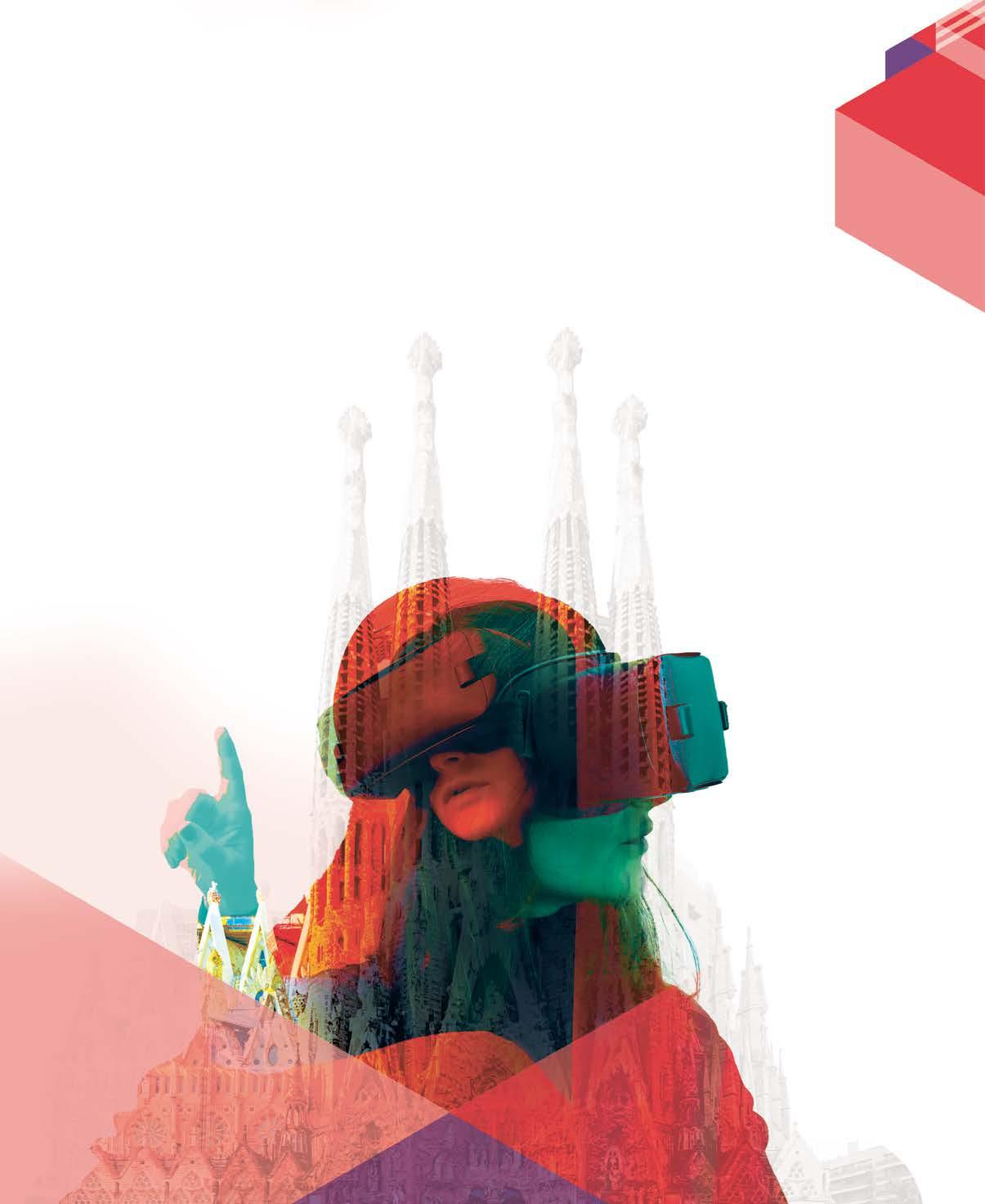

In 2020–2021 the Australian busi ness events industry, like many oth ers, was challenged by the lockdowns, travel bans, and social distancing restrictions associated with the Covid-19 pandemic. Mass gatherings of all kinds were cancelled, postponed or disrupted.
By April 2020 event industry professionals in Australia found themselves implementing new tech nologies capable of delivering virtual adaptations of the in-person meetings and conferences they had planned.
Virtual adaptions were, in fact, welcomed by many in the academic community who, prior to the pan demic, were already questioning traditional modes of conferencing (F2 F), and were looking to new alter natives to address problems related
to “geopolitics, continuing coloni alism, the soft politics and power hierarchies in academic societies, and the alleged need for extensive and excessive physical mobility” (Goebel et al., 2020). So, many associations were ready to pivot to the new cir cumstances and move their events into online formats.
Given the circumstances and the speed with which they and the sector had to pivot, what was achieved was remarkable, and the Australian “can do” spirit shone through. As a 2021 COSPAR delegate remarked in a recent survey we conducted, the masterful adaption to the challenges of staging the conference during the pandemic is testament to Australian collabora tion, pragmatism and resolve. The way we deliver and experience events
have continued to evolve consider ably in the past 18 months.
In 2020 Business Events Sydney commissioned Deborah Edwards, Carmel Foley and Anja Hergesell at the University of Technology Syd ney (UTS) to conduct research into the “new normal” for conferences held in New South Wales, Australia. While this research is ongoing, initial
F2 F business events include intense and intricate forms of inter action which involve language as well as the entire behavioural complex. This enables the establishment of common reference frames between individuals through mechanisms like rapid feedback, hand gestures, facial expressions, pointing and referring to objects in real space, subtle commu
bed nights, food consumption, and tourism.
This could prove challenging for an industry which has etched out its worth and value using such measures. our current research is looking at the impact of virtual attendance on these outcomes.
Thankfully, as a result of a decade of research investment by Australian convention bureaux (see Business Events Sydney's Beyond Tourism Benefits series), the Australian busi ness events industry incorporates a diverse approach to the way business events are conceptualised, lever aged, planned, delivered, studied and evaluated.
results indicate that delegates wel comed the options available to them in hybrid events.
Virtual attendance options made events more accessible in terms of mobility, finance and time. They didn't involve jet lag for long-haul passengers, offered easier access for those not able or willing to travel, and flattened some of the hierarchies that are inherent in an in-person, cen trally organised conference.
The carbon footprint of vir tual attendance is better for the planet, registration fees were lower, and there was no need to pay for accommodation.
Further, the timeframe for organ ising attendance at virtual events was shorter. Essentially, more people are able to attend more events more often when they are offered virtually. For these reasons virtual attendance will continue to be offered even when borders reopen, and delegates have indicated that they will continue to take advantage of such options.
nication cues, information interac tions and a shared local context.
So, it is not surprising that we also found that the energy, inspiration and atmosphere generated by likeminded people gathering together physically at meetings and confer ences is difficult to replicate in virtual settings. For these reasons, many delegates said they will continue to choose to travel to conferences in Australia to experience in-person events once the borders open.
However, the limitations to meaningful human connection for virtual attendees may be improved in the near future with ongoing techno logical and behavioural innovations in the design of hybrid conferencing experiences.
The new ‘normal’ for business events, incorporating both virtual attendance and F2 F options, will have flow on implications for business events in Australia and elsewhere in the world in terms of the physical size of conferences, conference delivery,
This research has been presented in public policy settings in Australia and government stakeholders have become increasingly aware of the significant scientific, social, and longterm economic value on offer; value that benefits our communities by directly driving development, creativ ity, partnerships and innovation.
As competition for public fund ing, potential delegates' time and other resources increases, the higher value proposition Australian business events have demonstrated and deliv ered to government, industry and community stakeholders has assisted the industry to be resilient during this turbulent period.
Another area that needs attention in the pivot to virtual conferencing is nurturing exhibitors and sponsors who, anecdotally, may not be realising the same benefits as they do in a F2 F format.
Improved efforts will be required to include them in the new virtual formats. For example, advertisements and links on conference social media platforms to boost views and traffic to their sites and social media pages, brief presentations slots in between scientific presentations akin to
“Virtual attendance options made events more accessible in terms of mobility, finance and time”
television advertising, and html flyers sent to delegates.
The future Business event organisers are adept at incorporating innovative ideas and new alternatives into event design. This is now more important than ever, requiring different design layers with numerous components that can be experienced on several levels and on multiple physical and virtual platforms.
Business event management of the future may be conceptualised as a highly creative product. A staged, temporary and intentionally designed experience in which multiple actors interact, share, create, contribute, serve, explore, learn and connect to achieve a range of planned and seren dipitous outcomes on multiple plat forms with impact and legacy created for a broad range of stakeholders. our research has continuously found that business events are unique and important catalysts for collabora tion, and for the creation of working relationships and friendships that are based on trust and common objec tives or interests. Collaborations formed at conferences have under pinned some of Australia's highest
achievements (see The Power of Conferences).
Time and again our studies indi cate that physical copresence is important for collaboration, knowl edge sharing and the formation of partnerships. Physical copresence creates the camaraderie, trust, relationships and friendships which underpin transformative social networks that drive collaboration, innovation and value cocreation.
However, this physical copresence may not need to be permanent, and once the trust, friendship or partner ship bonds have been created, they can be maintained through other means.
Australia will soon reopen its borders to international visitors and fortunately our business events industry has put in place the very best of practices, as well as research, to ensure our future delegates are safe and healthy, connected and inspired, and that communities, associations, industries and governments continue to benefit from the wealth of legacies and impacts that are leveraged from Australian business events.
They understand that the greatest value is when they deliver a legacy for
communities and future generations and results for their stakeholders.
Written by Carmel Foley and Deborah Edwards, University of Technology Sydney
Reference for direct quote: Goebel, J., Manion, C., Millei, Z., Read, R., & Silova, I. (2020). Academic conferencing in the age of Covid-19 and climate crisis: The case of the Comparative and International Educa tion Society (CIES). International Review of Education, 66(5), 797 816 . link.springer.com/ article/10 1007/s11159 020 09873 8
“F 2F business events include intense and intricate forms of interaction which involve language as well as the entire behavioural complex”

Convention bureaus need to ensure they stay relevant in the rapidly changing world of business events, not only in the marketplace but in their destination.
For too long, CBs have drawn an invisible circle around themselves and a few trusted allies. Not ventur ing outside the circle or letting others in, they are often only seen when requesting funding.
To be and stay relevant, conven tion bureaus need to understand the gaps and opportunities in the destina tions they represent. The best way to acquire this knowledge is to speak with and listen to as wide an audi ence of local stakeholders as possible. These conversations should occur not only with those with whom CBs are most familiar but also those from outside the industry. In other words, from sources beyond the invisible circle.
By casting a wider net, the con vention bureau will enhance its influence on matters of importance in their communities. Ultimately, being involved will help improve the products and experiences the CB is promoting to the market.
Convention bureaus should be finding ways to engage in discussions around infrastructure development, capacity building, public policy, accessibility, and social, environmen tal, health and security matters.
This does not mean diverting from the CBs role to sell and market the destination but evolving to a broader mandate. Without such a perspective,
the voice of the industry, and the cus tomer, will not be heard when deci sions are being contemplated which shape the future of the community (destination).
Destination planning is a tool which all CBs should become famil iar, as a way to widen influence and enhance relevancy. A relatively new field, destination planning is facili tated and encouraged by the conven tion bureau.
Destination plans are long-term, have a broad engagement process and outcomes which focus on the destina tion. Strategic plans, by comparison, focus on the CB itself, with outcomes directly influenced and controlled by them. The table below illustrates the key differences between these two types of planning.
Another key tool for CBs is to carry out objective and quantitative-based assessments designed to uncover the strengths and weaknesses of the destination.
For example, how does a destina tion stack up on hygiene factors, competitive advantages, and key differentiators? And based on these attributes, how well should the des tination be performing? Conducting such an assessment enables a CB to be better equipped to push for ways to address shortcomings with the public and private sectors.
Another tool is for convention bureaus to determine their role in key destination matters. Most CBs are accountable and responsible for
sales, marketing, and branding of the destination.
It is important to be clear whether other organisations also might see themselves as having this responsibil ity. If so, how does this get addressed? And how about such issues as infra structure, mobility, services, product experiences, policy and regulatory?
The CB should identify what role it would like to play. If not leading, the convention bureau should strive to be consulted or, in the least, be kept informed.
Being invited to the table where consequential decisions impacting a destination is something which is earned. CBs will benefit by stepping out of their comfort zone, getting acquainted with community needs through broad engagement, and in turn bringing the perspectives of the industry and marketplace to the decision process.
Tools such as destination plan ning, destination assessment, and role identification help CBs establish a meaningful contribution to these discussions.
Written by Paul Vallee, Executive Consult ant, Americas, with Gaining Edge. He has extensive experience consulting strategic and destination master planning, organisation development, and industry capacity building. His assignments include providing advisory support in Canada, the U.S., Denmark, Brazil, Colombia, Puerto Rico, Aruba, Panama, and Thailand.

Soon enough, face-to-face events will be a part of our lives once again. However, setting these experiences up will require a new tact. Here is how we think the return of face-to-face live events will look.
It is no secret that we are excited to see face-to-face experiences com ing back into play. However, after a year and a half of adapting to the Covid-19 pandemic, we must ask ourselves what should be considered when creating future experiences.
We are used to connecting through screens. While the technology existed before the pandemic, 2020 thrust names like Zoom and Teams into our daily schedules as our industry scrambled to adapt to the new rules of engagement. Now that we have adapted, the question we must ask is how we should return to face-to-face experiences?
Are we going back completely? In short, the answer is no, at least not for the entire industry. The digital engagement opportunities we found during the pandemic were discovered out of necessity, but that doesn't mean that we will be turning our backs on them in the future. Going digital helped towards solving our client challenges like budget, timing, and access.
Professionally and personally, our tech has allowed us to stay connected
with ease, kept us informed, and helped deal with being locked down. It would be naïve to assume that these avenues for connecting audi ences will disappear upon returning to the new normal.
one thing to bear in mind is something that we undoubtedly have all experienced is digital fatigue. With so much of our time spent in front of our devices, there have been over whelming reports of fatigue, lack of attention, and lapses in interest when experiences are formatted solely on digital platforms.
Since our devices have been our primary form of connection and escapism recently, time spent in front of screens should be crucial when designing an experience.
Soon, we will see hybrid elements playing a huge role in events. The pandemic fast-tracked the move towards the combination of analogue and digital elements within events. This shift will unlock new engage ment streams and overcome critical challenges that haunted events in years gone by.
Here is an example. When expand ing your audience base, there is a high chance of those audiences hailing from different time zones.
Hybrid helps us solve this challenge by splitting our event into different time zones, staggering the content
and helping to create a better shared virtual experience.
However, it is essential to remember that although engage ment streams can be separated using technology, it does not mean that your event will be disjointed. You will be able to segment your content into digestible and focused portions and even target the most relevant sections to their respective locations. Hybrid is about increasing audiences, not dividing them.
When pivoting events to a more hybrid-focused design, we must re-evaluate what you can sell your experience on. This is one of the criti cal considerations that must be taken into account from now on. Previously, we promoted events on keynote speakers and special guests attending, but a new environment always calls for a new approach.
An exciting part of hybrid events is the shift in how your audience engages with your event and the boosted attendance through digital audience streams. But this may come with the added challenge of finding new ways to draw people in.
There is a new way to make expe riences live long after the physical event has ended by using hybrid solutions. By factoring in digital com munications for before, during, and after the event, the opportunities for
education, excitement, and network ing can be tremendous.
It is up to us all to utilise this tech nology, design our audience journey from the very start, and reap the benefits from the hybrid.
What we may even see in the future is an emergence of new plat forms that allow you to stay con nected with your audiences and keep the conversations going. In the return of face-to-face, we expect to see expe
sometimes within very short deadlines.
Regarding long-term commit ment, ROI, and innovative strategies, I asked for input from our global MCI experts to share their experiences. The expectations of sponsors have radically changed in the digital space. How do we ensure that these expec tations are met?
Some were not ready for the virtual transition, so it was necessary
their partners. Beyond supporting associations, partners must justify the investment made. If this invest ment is profitable, then the asso ciation will be able to retain them and ensure the sustainability of its income more easily. With event virtualisation, sales pro cesses have accelerated. What impact does this have on the events of asso ciations and societies?
With virtual, the income related to registrations is considerably reduced (and sometimes even free). The sponsorship of events, therefore, has an increasingly important role in the financing and survival of the event.
Before transforming an event, you have to study all its aspects. This exercise is essential because it will influence the time of communication, prospecting and sales. To reassure the partners, we take time with each of them.
riences starting in emails, moving to expo halls, and finishing on personal devices.
When you bring the best elements of virtual and analogue experiences together, you truly create an environ ment for success. The right hybrid solutions can open up new avenues for engagement, education, and ulti mately, revenue.
over a year later, with the can cellation or postponement of faceto-face events and the transition to virtual, the expectations and needs of sponsors and partners have changed. The commercial offer of learned associations and societies had to be adapted accordingly to meet them best.
This transition has been greatly accelerated with the health situation. The partners have dealt with more than expected with the modalities of virtualisation of their participation,
to accompany them and reassure them throughout their preparation. MCI decided to involve and engage partners in a more global reflection on their experience of hybrid and, or virtual, on the future of events and their positioning with associations.
This study made it possible to highlight that many of them do not calculate their return on investment (ROI) because they do not have tools or methods available, or they do not have the necessary time.
The digitisation of events has enabled some partners to assess this ROI thanks better to easily quantifi able data. Soon, hybridisation will also make it possible to provide face-to-face ROI assessment tools and methods, which was more difficult to calculate in the past.
one of our missions as a consult ing partner is to convince associa tions of the importance of ROI for
There is a setup of explanatory videos or webinars for partners to have all the cards in hand to boost their virtual space and be operational on the proposed virtual platform. In a reasonably short time, you have to be very efficient. This considerably reduces the prospecting time. Marketing budgets have been reduced, and, as a result, sponsors are forced to rethink their investment strategies. How do you help your clients adapt their packages? What innovative strategies have you put in place to guarantee the ROI?
In times of crisis, marketing budgets are traditionally the first to be cut. However, the need to reach new customers, generate leads, find opportunities is stronger than ever. For this, each marketing investment must be relevant, objectified, profit able and measurable.
our first action is to generate in-depth knowledge (interviews,
“Hybrid is about increasing audiences, not dividing them”
polls, surveys, etcetera) of the specific needs of each major sponsor. We can then support our association clients in redesigning their offer in an “à la carte” spirit.
The second step is the monitor ing and optimisation of the ROI of each sponsor via a “ROIste” consult ing/coaching offer intended for the sponsors. In this, digital offers end less possibilities. In face-to-face and hybrid, the in-depth knowledge of sponsors and visitors allows us to ensure that the right offer meets the proper demand. What strategy can be adapted to maintain the long-term commitment of sponsors and exhibitors through virtual or hybrid events?
The virtualisation and hybridisa tion of events are significant upheav als in the exposure habits of sponsors, who suddenly have to revisit a copy that had never been imagined other than face-to-face.
The strategy for maintaining the long-term commitment of sponsors and exhibitors is to involve them in the event virtualisation process. The virtualisation and hybridisation of events are significant upheavals in the exposure habits of sponsors, who suddenly have to revisit a copy that had never been imagined other than
face-to-face. They should not feel like spectators (or worse, hostages) of the transformation but rather cocon structors of this new participation formula.
By consulting them on the various key phases in the development of the offer and the platform, as well as by training them on the use of new tools so that they understand how it works upstream of the event, the sponsors will feel involved as a stakeholder and no longer just as a user.
A better understanding of the measurement of the ROI of sponsors is also one of the keys to their longterm commitment. Qualifying visi tors exhaustively will allow exhibitors to use comprehensive statistics and optimise the cost/contact ratio, one of the driving forces behind participa tion in a congress.
So, what will the sponsorship land scape look like in 2021 and beyond?
According to MCI, sponsorship in 2021 and beyond will continue to evolve towards a collaborative part nership model. We were on the path to this evolution, but Covid-19 accel erated the process. Staying relevant takes creativity.
Exchanges between potential sponsors and affiliated organisations should be anchored in collaboration,
listening to needs and analysing performance. If content is king, data is queen, and together they open the door to levers of opportunities for associations and sponsors.
The way forward, however, is not straightforward. It requires strategic planning, creativity and a willingness on all sides to explore and push the boundaries of their collaboration.
The codevelopment of educational content, the colocation of affiliate programmes, the optimisation of digital marketing, the volume effect, hybrid mechanisms, the extended lifespan of the content, the engage ment of targeted populations, ROI, data analysis and reporting are among the many topics that must be addressed in the design of new part nership offers.
This is to establish a broad, dynamic and relevance-based col laboration to achieve the objectives of the association and the sponsors.
Written by Per Ankaer, Director of MCI Nor dics in Copenhagen. MCI is one of the leading meeting and event planners in the Nordics
“A new environment always calls for a new approach … Staying relevant takes creativity”
The GDS-Movement unites and enables destination management professionals to create flourishing and resilient places to visit, meet and live in. Their mission is to cocreate sustainable and circular strategies, mindsets and skillsets that will enable future destinations to thrive and soci ety and nature to regenerate.
They work with pioneering munic ipalities, national/regional destina tion management organisations, and convention bureaus to cocreate their tourism and events strategies, bench mark and improve their sustainability performance, and transform their value chains to catalyse regeneration.
The GDS-Movements work is aligned with the UN 2030 Agenda. They are working to mainstream the integration of the 17 Sustainable Development Goals (SDGs) into the management and strategies of desti nations globally. They are, of course, a partner of the UN one Planet Sustain able Tourism Programme and their working group for “Circularity in tourism.”
The GDS-Index uses 71 indica tors that evaluate destinations sustainability performance across four key areas. City Environmental Performances, City Social Per formance, Supplier Performance
and Destination Management Performance.
The Sustainability Pavilion at Expo 2020 Dubai will be a centre piece of the event. The building is called “Terra”, meaning planet Earth, and generates fresh water from the surrounding humid air. In addition, its 130 metres-wide roof canopy and surrounding “Energy Tree” struc tures are fitted with more than 1000 solar panels, which will provide some of the energy needed to host this mas sive event.
“We're trying to showcase that humanity can build buildings that do live in harmony with the environ ment around them, that do manage to grab the resources around them whether that's sun or water,” explains John Bull, director of the Sustaina bility Pavilion said in a CNN interview.
“Even in this environment, which is somewhat dry, we're still able to get enough water which allows this building to be self-sufficient. This pavilion was the first of the Expo structures to be completed. Residents and visitors are offered a wide range of interactive experiences to help people understand their impact on the environment.
“Through those immersive and interactive experiences, that's how we
can really connect to people. That's how you start conversations that mat ter, rather than just giving informa tion,” says John Bull.

Expo 2020 Dubai is running from 1 october 2021 to 31 March 2022 . once the event is over, the Sustaina bility Pavilion will form part of a science centre in District 2020, a new residential and business development that will evolve from the Expo site.
How far are we from the UN goals of 2030? It's only nine years from now. The Business Event Industry is a meta-industry that has an impact on all other industries. Just look at Expo 2020.
We will be in Dubai for a week at the end of November and only work at the Expo, and one fundamental issue on our agenda is the sustaina bility and the sustainability pavilion. Let's see how far we have come, and let's meet in Dubai.
Missed conversations, reconnecting with old friends and yearning to make trusted new connections. The journey back starts today.
Registration is open for IMEX America 2021 , taking place at Mandalay Bay, Las Vegas from November, 9-11


Join us on the road to Mandalay-YAY! It’s going to be a memorable trip! Visit imexamerica.com to register now. Some things are worth waiting for Stay in touch on social #WeWillMeetAgain
We have always been proud to be a place that brings people from all over the world together. A venue, purpose-built for making connections, where people make friends, collaborate on ideas and collectively share in an unrivalled event experience.
What events look like may have changed, but how they feel, and the impact they have, doesn’t have to. We are here to help you find new ways of connecting, so you can continue to inspire delegates and create shared experiences, while navigating new social norms.
We’re looking forward to welcoming the world back to The CCD soon.
